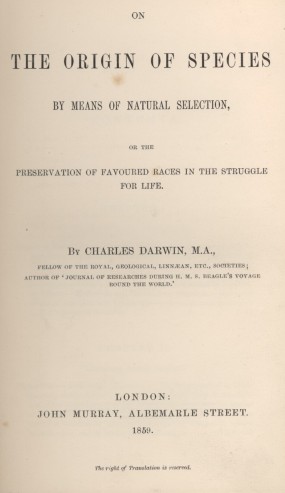Charles Darwin: gentleman naturalist
A biographical sketch by John van Wyhe
| Audio version of this introduction - YouTube |
 CHARLES Robert Darwin (1809-1882) was born the fifth of six children into a wealthy Shropshire gentry family in the small market town of Shrewsbury. His father, the hugely portly Robert Waring Darwin (1766-1848), was a successful physician and financier and son of the famous poet and philosopher, Erasmus Darwin. Charles Darwin's mother, Susannah Wedgwood (1765-1817), from the famous potter Wedgwoods, died when he was eight years old. Although his mother belonged to the very liberal Unitarian denomination and his father was a freethinker, Darwin was baptised in the Church of England and grew up an average Christian for his time and social background.
CHARLES Robert Darwin (1809-1882) was born the fifth of six children into a wealthy Shropshire gentry family in the small market town of Shrewsbury. His father, the hugely portly Robert Waring Darwin (1766-1848), was a successful physician and financier and son of the famous poet and philosopher, Erasmus Darwin. Charles Darwin's mother, Susannah Wedgwood (1765-1817), from the famous potter Wedgwoods, died when he was eight years old. Although his mother belonged to the very liberal Unitarian denomination and his father was a freethinker, Darwin was baptised in the Church of England and grew up an average Christian for his time and social background.
Darwin, watched over by his elder sisters and maidservants, grew up amidst wealth, comfort and country sports. He attended the nearby Shrewsbury Free Grammar School as a boarder from 1818-1825. Darwin's Autobiography remains one of the most important sources on his early life.
In October 1825 Darwin went to Edinburgh University with his elder brother Erasmus to study medicine with a view to becoming a physician like his father and grandfather. See some of his student notes in CUL-DAR5, transcribed only in Darwin Online. Darwin joined a scientific student society called the Plinian Society where he gave his first scientific papers in March 1827 (here). See also his zoological walk to Portobello, 1826.
While in Edinburgh Darwin investigated primitive sea creatures with the guidance of a gentleman naturalist, Dr Robert Grant. Darwin's name first appeared in print in one of Grant's articles. One of Darwin's first scientific notebooks survives from this time, the Edinburgh notebook (here).
Darwin did not like the study of medicine and could not bear the sight of blood or suffering and so his father proposed the church as a respectable alternative for someone of his social position. The advantage to becoming a country parson, as Darwin saw it, would be the 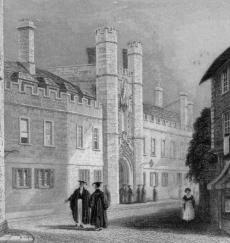 freedom to pursue his growing interest in natural history. He read several books on Christianity while making up his mind. Some of his notes survive here. To become ordained in the Church of England he must first obtain a B. A. degree from an English university. He did not study divinity or theology as claimed by countless publications- there was no such degree.
freedom to pursue his growing interest in natural history. He read several books on Christianity while making up his mind. Some of his notes survive here. To become ordained in the Church of England he must first obtain a B. A. degree from an English university. He did not study divinity or theology as claimed by countless publications- there was no such degree.
On 15 October 1827 Darwin was admitted a member of Christ's College, Cambridge. However, as he had forgotten most of the Greek he had learned at school, and advanced Greek was required in the daily college lectures, Darwin could not come up in October. He studied under a private tutor at home until he was able to translate Greek with some ease. Therefore he did not come into residence in Cambridge until 26 January 1828.
As all of the College rooms were full, Darwin first stayed in lodgings for Christ's students above W. Bacon, the tobacconist, on Sidney Street just down the street. (The original building was demolished in the 1930s but two plaques on the site of a branch of Boot's the chemist mark the location today.) He matriculated at the Senate House on 26 February 1828 (not in January as in some biographies). Darwin's student bills were recently discovered at Christ's College and shed new light on his time in Cambridge. Legend has it that Darwin stayed in the same rooms as the famous natural theologian, William Paley, author of Natural theology. This is a recent myth. The only book on Darwin as a student in Cambridge is Charles Darwin in Cambridge: The most joyful years. (Paperback, Kindle) See more on Darwin's restored student rooms here & here.
Darwin's cousin, William Darwin Fox, was at Christ's just before Darwin and overlapped with him for a short time. See Fox's diary and accounts recording his early time at Christ's here (Reproduced by permission of Gerry Crombie. Photographed by Colin Higgins.)
Darwin was never a model student, but he did become a passionate amateur naturalist. He began avidly collecting beetles along with a few fellow undergraduates. His name appeared in print when some of his records of insect captures were published by Stephens in his British Entomology in 1829. All of the mentions of Darwin there are included in Darwin Online. Darwin's first published word was "Cambridge".

Some of Darwin's student beetle collection. Cambridge Zoology Museum. Photograph John van Wyhe.
Darwin became the devoted follower of Professor of botany John Stevens Henslow (1796-1861). Through their close friendship Darwin learned a great deal about the practice of natural science. Darwin passed his B.A. examination in January 1831. As he had not fulfilled the residence requirement to take a degree, it was not awarded until 26 April 1831. Shortly thereafter he was taught the rudiments of field geology by Professor Adam Sedgwick during a tour of north Wales.
Soon thereafter Henslow was able to pass on to Darwin the offer of Commander Robert FitzRoy of travelling on a survey ship, HMS Beagle, as a "scientific person" or naturalist. Darwin was not, as fashion has had it for many years, really on board as the captain's companion. And, contrary to another belief of recent years, the ship's surgeon was not the default naturalist. So, surprisingly, the traditional facts here are more accurate than most modern scholarship- Darwin was indeed the official naturalist on the Beagle. See here.
The round-the-world journey lasted about five years. Darwin spent most of these years investigating the geology and 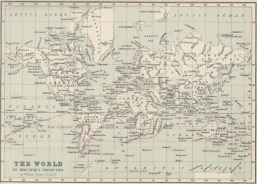 zoology of the lands he visited, especially South America, the Galapagos islands, and Pacific oceanic islands. His massive geological diary, the largest document from the voyage of the Beagle, is transcribed only on Darwin Online here. He recorded many of his specimens and observations immediately in field notebooks - first published in full in Darwin Online. His telegraphic pocket notes were later used in writing up more formal notes, such as his animal notes. Later he recorded his experiences in a diary which became the basis of his famous book Journal of researches (1839) now known as Voyage of the Beagle. (This latter title was first used on the title page of a 1905 edition.)
zoology of the lands he visited, especially South America, the Galapagos islands, and Pacific oceanic islands. His massive geological diary, the largest document from the voyage of the Beagle, is transcribed only on Darwin Online here. He recorded many of his specimens and observations immediately in field notebooks - first published in full in Darwin Online. His telegraphic pocket notes were later used in writing up more formal notes, such as his animal notes. Later he recorded his experiences in a diary which became the basis of his famous book Journal of researches (1839) now known as Voyage of the Beagle. (This latter title was first used on the title page of a 1905 edition.)
Darwin Online provides the world's largest amount of materials on the Beagle voyage. see here
Darwin was particularly influenced by the works of men of science like astronomer Sir John Herschel, traveller and naturalist Alexander von Humboldt and geologist Charles Lyell. Lyell's new book, Principles of Geology (1830-3), profoundly influenced Darwin. Lyell offered not just a new geology but a new way of understanding nature. Lyell showed how tiny, slow, gradual and cumulative change over immense periods of time could produce large changes. Natural, visible, non-miraculous causes should be sought to explain natural phenomenon. Darwin had the opportunity to witness all of these forces, such as erosion, earthquakes and volcanoes, during the Beagle voyage and he became convinced that Lyell's views were correct. Darwin made several very important discoveries about the geology of South America, volcanic islands and the origins of coral reefs by building on Lyell's ideas. Darwin later wrote in the 2nd edition of his Journal of researches:
Where on the face of the earth can we find a spot, on which close investigation will not discover signs of that endless cycle of change, to which this earth has been, is, and will be subjected?
Darwin also collected organisms of all sorts which he recorded in his specimen lists and zoology notes. These formed the basis of the five volume series he edited and superintended after returning home The zoology of the voyage of H.M.S. Beagle (1838-43).
Sections from Darwin's Geological observations on South America.
Darwin also unearthed many fossil creatures in South America. He wondered why the fossils resembled the present inhabitants of that continent more than any other species. Where had the new species come from? In fact, why was the world covered with so many different kinds of living things? Why were some very similar to one another and others vastly different? If species were somehow created to fit their environments, as was then believed, why were jungle species different in Asia, Africa and South America despite the similarity of climate?
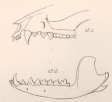 Darwin did not conceive of a solution during the Beagle voyage, but rather a few years later in London, while writing books on his travels and studying the specimens he had collected. Experts in London, such as the ornithologist John Gould, were able to tell him how many of the specimens of plants and animals he had collected in the Galapagos Islands were unique species, found nowhere else. Clearly they resembled species from South America 600 miles away. It seemed to Darwin as if stray migrants from South America had come to the Galapagos, after the islands rose from the sea as volcanoes, and then changed over time in isolation on the islands.
Darwin did not conceive of a solution during the Beagle voyage, but rather a few years later in London, while writing books on his travels and studying the specimens he had collected. Experts in London, such as the ornithologist John Gould, were able to tell him how many of the specimens of plants and animals he had collected in the Galapagos Islands were unique species, found nowhere else. Clearly they resembled species from South America 600 miles away. It seemed to Darwin as if stray migrants from South America had come to the Galapagos, after the islands rose from the sea as volcanoes, and then changed over time in isolation on the islands.
Darwin began to speculate on how new species could arise by natural observable causes. His idiosyncratic eclecticism led him to investigate some unconventional evidence. He made countless inquiries of  animal breeders, both farmers and hobbyists like pigeon fanciers, trying to understand how they made distinct breeds of plants and animals. Gradually Darwin concluded that organisms were infinitely variable, and that the supposed limits or barriers to species was a belief without foundation. In modern terms we would say that Darwin came to accept that life evolves. One conventional view of the time was that species had been created where they are now found, in accordance with the environment. Few men of science then held to the view that there had been only a single species creation event. The fossil evidence seemed to show very many creations had occurred in different geological eras.
animal breeders, both farmers and hobbyists like pigeon fanciers, trying to understand how they made distinct breeds of plants and animals. Gradually Darwin concluded that organisms were infinitely variable, and that the supposed limits or barriers to species was a belief without foundation. In modern terms we would say that Darwin came to accept that life evolves. One conventional view of the time was that species had been created where they are now found, in accordance with the environment. Few men of science then held to the view that there had been only a single species creation event. The fossil evidence seemed to show very many creations had occurred in different geological eras.
Darwin then sought to explain how living forms changed over time. He was familiar with the evolutionary speculations proposed earlier by his grandfather Erasmus Darwin and by the great French zoologist Jean-Baptiste Lamarck. But already Darwin's theorizing had extended in novel directions. He was thinking of the history of life not as a number of independent lineages somehow impelled to progress upwards from monads to monkeys. Instead Darwin saw all life as a single genealogical tree, branching and rebranching. Thus similarities between different kinds of living things would be expected from their joint ancestry or common descent. (See Hodge 2005) Darwin's speculations and early theorizing were recorded in a series of notebooks similar to those he kept during the Beagle voyage.
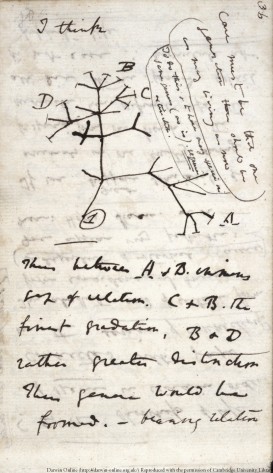 In September 1838 Darwin read Thomas Malthus's Essay on the Principle of Population (1798). As Janet Browne has written, Darwin was 'clearly following up lines of inquiry relating to individual variation, averages, and chance, as well as seeking information on human population statistics.' (Browne 1995, p. 385) Malthus argued that human population growth, unless somehow checked, would necessarily outstrip food production. Population growth was geometrical. For example, two parents might have four children, each of whom could have four children, whose children could also have four children. Thus in four generations there would be an increase from 2 to 4 to 24 to 96 and so forth.
In September 1838 Darwin read Thomas Malthus's Essay on the Principle of Population (1798). As Janet Browne has written, Darwin was 'clearly following up lines of inquiry relating to individual variation, averages, and chance, as well as seeking information on human population statistics.' (Browne 1995, p. 385) Malthus argued that human population growth, unless somehow checked, would necessarily outstrip food production. Population growth was geometrical. For example, two parents might have four children, each of whom could have four children, whose children could also have four children. Thus in four generations there would be an increase from 2 to 4 to 24 to 96 and so forth.
The focus of this argument inspired Darwin. He realised that an enormous proportion of living things are always destroyed before they can reproduce. This must be true because every species would otherwise breed enough to fill the earth in a few hundred generations. Instead populations remain roughly stable year after year. The only way this can be so is that most offspring (from pollen, to seeds and eggs) do not survive long enough to reproduce.
Darwin, already concentrating on how new varieties of life might be formed, suddenly realised that the key was whatever made a difference between those that survive to reproduce and those that do not. He came to call this open-ended collection of causes 'natural selection' because it was analogous to breeders choosing which individuals to breed from and thus changing a breed markedly over time.
As Darwin wrote in his Autobiography in 1876: 'In October 1838, that is, fifteen months after I had begun my systematic enquiry, I happened to read for amusement Malthus on Population, and being well prepared to appreciate the struggle for existence which everywhere goes on from long-continued observation of the habits of animals and plants, it at once struck me that under these circumstances favourable variations would tend to be preserved, and unfavourable ones to be destroyed. The result of this would be the formation of new species. Here, then, I had at last got a theory by which to work'. Below is the famous passage from Darwin's notebook where these ideas were first recorded:
[Sept] 28th.[1838] Even the energetic language of <Malthus> «Decandoelle» does not convey the warring of the species as inference from Malthus.— «increase of brutes, must be prevented soley by positive checks, excepting that famine may stop desire.—» in Nature production does not increase, whilst no checks prevail, but the positive check of famine & consequently death..
...—The final cause of all this wedging, must be to sort out proper structure, and adapt it to change.—to do that for form, which Malthus shows is the final effect by means however of volition of this populousness on the energy of man. One may say there is a force like a hundred thousand wedges trying [to] force every kind of adapted structure into the gaps in the economy of nature, or rather forming gaps by thrusting out weaker ones. [Notebook D, 134e-135e]
Or, as Darwin later put it in the Origin of species (1859):
As many more individuals of each species are born than can possibly survive; and as, consequently, there is a frequently recurring struggle for existence, it follows that any being, if it vary however slightly in any manner profitable to itself, under the complex and sometimes varying conditions of life, will have a better chance of surviving, and thus be naturally selected. From the strong principle of inheritance, any selected variety will tend to propagate its new and modified form.
Therefore only the survivors would pass on their form and abilities. Their characteristics would persist and multiply whilst characteristics of those that did not live long enough to reproduce would decrease. Darwin did not know precisely how inheritance worked—genes and DNA were totally unknown. Nevertheless he appreciated the crucial fact of inheritance. Offspring resemble their parents. Darwin thought in terms of populations of diverse heritable things with no essence—not representatives of ideal types as many earlier thinkers had done. From his observations and experiments with domesticated and wild plants and animals he could find no limits to the extent organic forms could vary and change through generations. Thus the existing species in the world were related not along a 'chain of being' or separated into artificially separate species categories but were all related on a genealogical family tree through 'descent with modification'.
As Darwin wrote in the Origin of Species (1859):
why should the species which are supposed to have been created in the Galapagos Archipelago, and nowhere else, bear so plain a stamp of affinity to those created in America? There is nothing in the conditions of life, in the geological nature of the islands, in their height or climate, or in the proportions in which the several classes are associated together, which resembles closely the conditions of the South American coast: in fact there is a considerable dissimilarity in all these respects. On the other hand, there is a considerable degree of resemblance in the volcanic nature of the soil, in climate, height, and size of the islands, between the Galapagos and Cape de Verde Archipelagos: but what an entire and absolute difference in their inhabitants! The inhabitants of the Cape de Verde Islands are related to those of Africa, like those of the Galapagos to America. I believe this grand fact can receive no sort of explanation on the ordinary view of independent creation; whereas on the view here maintained, it is obvious that the Galapagos Islands would be likely to receive colonists, whether by occasional means of transport or by formerly continuous land, from America; and the Cape de Verde Islands from Africa; and that such colonists would be liable to modification;—the principle of inheritance still betraying their original birthplace.
Darwin also identified another means by which some individuals would have descendants and others would not. He later called this sexual selection.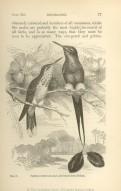 This theory explained why the male sex in many species produce colourful displays or specialised body parts to attract females or to compete against other males. Those males who defeat other males, or are selected for breeding by females leave more offspring and so subsequent generations resemble them more than those who succeed less often. As Darwin pointed out, "A hornless stag or spurless cock would have a poor chance of leaving offspring." (Origin, p. 88)
This theory explained why the male sex in many species produce colourful displays or specialised body parts to attract females or to compete against other males. Those males who defeat other males, or are selected for breeding by females leave more offspring and so subsequent generations resemble them more than those who succeed less often. As Darwin pointed out, "A hornless stag or spurless cock would have a poor chance of leaving offspring." (Origin, p. 88)
Darwin, deeply studied in the sciences of his time, yet living somewhat independently from his colleagues, was able to think in new ways and to conceive of worlds quite unimaginable to his more orthodox friends. However, the legend of Darwin as a lone genius discovering evolution on the Galapagos Islands is now known by historians to be a groundless myth.
It is now clear that Darwin did not keep his ideas about species changing secret; he discussed them with many friends, family and colleagues during succeeding years. But his full-time occupation before and long after he became an evolutionist was the publication of his scientific work from the Beagle voyage.
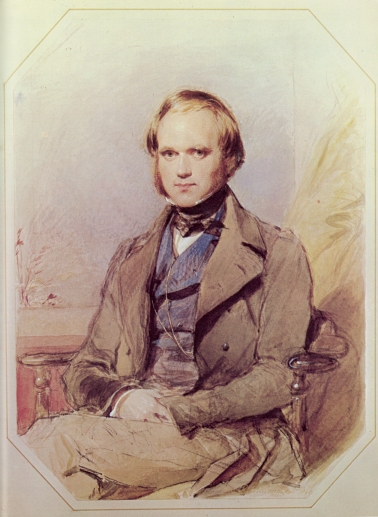
Darwin in 1840. Watercolour by George Richmond. Reproduced courtesy of the Darwin Heirlooms Trust.
He married his cousin Emma Wedgwood (1808-1896) in 1839. The marriage was a very happy one. Emma's diary provides unique information about their lives for many decades such as where they went and what visitors they received. Her diary is published only in Darwin Online, here.
See also the only online itinerary of Darwin's whereabouts during his lifetime here.
Darwin's many acute and innovative books and articles forged a great reputation as a geologist, zoologist and scientific traveller. His eight years gruelling work on barnacles, published 1851-4 enhanced his reputation as an authority on taxonomy as well as geology and the distribution of flora and fauna as in his earlier works. Nevertheless there is no reason to allege, as is so often done, that Darwin needed to supplement his reputation or skills before he could publish his species theory. Marine invertebrates had been of central interest for Darwin since his student days in Edinburgh. During the Beagle voyage a large proportion of his zoology notes were devoted to them, and he did not give this class of organisms to another expert to identify but kept them for himself.
Extract from Darwin's catalogue of microscope slides of barnacle specimens.
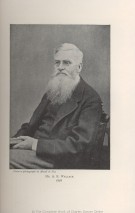 Darwin conducted breeding experiments with animals and plants and corresponded and read widely for many years to refine and substantiate his theory of evolution. In 1842 he prepared a brief sketch outlining his theory. This was greatly expanded in an essay written in 1844. It is widely believed that in a memo written to his wife, Darwin asked her to publish this only after his death. This is utterly false. One has only to read the memo itself where Darwin explicitly states that in case of his unexpected premature death she should find a competent naturalist to do the extensive work necessary to put it in a publishable condition. He was not finished yet.
Darwin conducted breeding experiments with animals and plants and corresponded and read widely for many years to refine and substantiate his theory of evolution. In 1842 he prepared a brief sketch outlining his theory. This was greatly expanded in an essay written in 1844. It is widely believed that in a memo written to his wife, Darwin asked her to publish this only after his death. This is utterly false. One has only to read the memo itself where Darwin explicitly states that in case of his unexpected premature death she should find a competent naturalist to do the extensive work necessary to put it in a publishable condition. He was not finished yet.
After completing his work on barnacles Darwin immediately turned to his theory to explain species. He was more than half way through a great work on the subject when he was interrupted on 18 June 1858 by a letter from an English naturalist and collector, Alfred Russel Wallace (1823-1913). Wallace was then collecting natural history specimens in South East Asia. For many years the date of the arrival of this letter was shrouded in conspiracy theories based on fallacious historical reasoning by amateur writers. Its actual sending and receipt dates have now been proven. See van Wyhe and Rookmaaker, A new theory to explain the receipt of Wallace's Ternate Essay by Darwin in 1858. Biological Journal of the Linnean Society (2012) and John van Wyhe, Dispelling the darkness (2013), pp. 225-6, 358 note 692.
In an essay enclosed, Wallace described his ideas 'On the Tendency of Varieties to Depart Indefinitely From the Original Type'. Darwin was struck by the similarity, even thinking it was an identical theory, something historians of science have shown not to be the case. For a historical (and not a anachronistic or hagiographical) explanation of Wallace's essay, see Dispelling the darkness, pp. 208-217.
Great caution and scepticism is needed when reading about Wallace today. Almost all writings about him since the 1970s have been produced by writers without historical training or qualifications who came to believe in and created a new narrative of Wallace unlike the historically accurate one that existed before the 1960s. In the hands of conspiracy theorists, Wallace came to be seen as tragically forgotten or unfairly overshadowed or the victim of conspiracies to rob him of his priority. This 'popular science magazine' sort of history has been all pervasive for decades and a generation of historians has grown up believing in it.
These victim-hero myths all share two common denominators- to exaggerate Wallace's hardships and disadvantages and to extol him as a great hero genius. Needless to say, these motives are diametrically opposed to real historical scholarship.
The 'popular science magazine' era narrative and its huge number of myths and mistakes about Wallace have been overturned by serious scholarly research in recent years. Nevertheless, Wallace fans already invested in the 'popular science magazine' 'victim Wallace' continue to promote this narrative and to angrily dismiss and attack the serious scholarship that has overturned it.
Darwin sent the letter on to Charles Lyell the same day as requested, and it was eventually decided, particularly by Darwin's friend J. D. Hooker, to avoid competition for priority, to read unpublished documents by both men in the same presentation. The papers were read, in the absence of Darwin and Wallace, at a meeting of the Linnean Society of London on 1 July 1858 and later published in their Proceedings. Today it is a celebrated event but at the time was decidedly little noticed. It started no revolution in science. Indeed, as far as the historical evidence reveals, the combined papers seem to have converted not a single person to believe in evolution.
The fate of Wallace's letter to Darwin and the manuscript of Wallace's Ternate essay were definitively revealed in Dispelling the Darkness in 2013:
The Ternate essay, after its epic journey of 9,240 miles from Ternate to London by steamship, camel and steam train, and then back and forth between Darwin, Lyell, Hooker and the Linnean Society, ended up at the printers Taylor and Francis at Red Lion Court, Fleet Street. Here it was set in type for publication in the Journal of the Linnean Society. The Ternate essay was unceremoniously discarded by the printers like other manuscripts that went into the journal.
Darwin sent the original Wallace letter to Lyell in their subsequent exchanges and it was never mentioned again.
Darwin was then urged by friends to publish an overview of his book-in-progress on evolution by natural selection. This abstract became one of the most influential books ever written: On the Origin of Species (1859). Almost every writer on this episode uses the word "rushed". Darwin did not rush. He spent 13 months condensing his 20 years of research and writing into a single volume.
Although Darwin convinced most of the international scientific community within 15-20 years that descent with modification, or evolution, was true, many did not accept natural selection as the primary mechanism. Darwin was not the first to propose that species can change. A glance at his 'An historical sketch of the progress of opinion on the origin of species' added to the 3rd edition of Origin shows that Darwin made no pretence to have originated or discovered evolution per se. However, Darwin's understanding of branching descent was more accurate, refined and convincing than his predecessors who considered, for example, that the members of one genus might be commonly derived. We know that a wide popular literature such as George Combe's Constitution of Man (1828) and the anonymous Vestiges of the Natural History of Creation (1844) had already shocked and converted vast popular audiences to belief in the power of natural laws to control the development of nature and society. Historians of science now believe that Darwin's effect was, as James Secord put it, a 'palace coup' amongst elite men of science rather than a revolution. Indeed recent research suggests that the reaction to Darwin's Origin was less of a furore than once believed. (Fleming & Goodall 2002) The Darwin Online project has identified and published the largest collection of reviews of any figure in the history of science, including the reviews of Origin. Nevertheless to the end of his life Darwin was regarded as a great scientific revolutionary who had overturned the ideas of his generation.
Darwin, as an unquestionably respectable authority in elite science, publicly threw his weight on the side of evolution, and soon young allies like Hooker, T. H. Huxley and John Tyndall publicly threw their own weight towards the same position. Darwin's name is so linked with evolution because he was the first to conceive of and share with others the theory of evolution by natural selection and his works convinced the international scientific community that evolution was true.
Like Combe, Charles Babbage, Robert Chambers, Herbert Spencer and countless other authors before him, Darwin represented his doctrine as furthering the domain of natural laws. We see this in the following epigraph Darwin used for the Origin of Species:
"But with regard to the material world, we can at least go so far as this-we can perceive that events are brought about not by insulated interpositions of Divine power, exerted in each particular case, but by the establishment of general laws."
W. WHEWELL : Bridgewater Treatise.
Darwin even saw the power of his law of natural selection extending beyond life to what we would call psychology, linguistics and to society and history (see for example Descent of Man, 1871, chapter 3).
In the Origin of Species Darwin first tried to convince his readers that organisms are malleable and not fixed natural kinds. He demonstrated that domesticated plants and animals were known to be highly variable and to have changed so much as to be classified as different species if they were not already familiar.
He then showed that the existence and abundance of organisms was dependent on many factors, which tended to hold their numbers in check such as climate, food, predation, available space etc.
Only then did Darwin set about showing the effects of differential death and survival on reproduction and the persistence and diversification of forms—natural selection. In other words Darwin's theory of evolution has three main elements or requirements: variation, selection and heredity. If all individual life forms are unique, which no one denied, and these differences could make a difference to which organisms lived to reproduce and which did not, then, if these differences could be inherited by offspring, subsequent generations would be descended from those which were lucky enough to survive.
An illustrative example is seen in the recent work of biologists in the Galapagos Islands. During a drought season when no new seeds were produced for an island's finches to eat, the birds were forced to hunt for remaining seeds on the ground. Soon all the visible seeds had been devoured. It so happened that those with slightly thicker beaks than average could turn over stones a little bit better than the rest to find the remaining seeds and so the birds which survived the famine tended to be thicker beaked. When the drought ended and the birds again had young, this new generation had slightly thicker beaks. This is an example of Darwinian evolution observed and measured in the field. (See Weiner. 1994. Beak of the Finch.)
Darwin's theory of genealogical evolution (as opposed to earlier theories by Lamarck or Vestiges which entailed independent lineages unfolding sequentially because of an innate tendency towards progress) made sense of a host of diverse kinds of evidence such as the succession of fossil forms in the geological record, geographical distribution of life (biogeography), recapitulative appearances in embryology, homologies like the hand of a man and the wing of a bat, vestigial organs, nesting taxonomic relationships observed throughout the world and so forth.
The famous last paragraph of the Origin of Species is a concise and eloquent précis of Darwin's vision:
It is interesting to contemplate an entangled bank, clothed with many plants of many kinds, with birds singing on the bushes, with various insects flitting about, and with worms crawling through the damp earth, and to reflect that these elaborately constructed forms, so different from each other, and dependent on each other in so complex a manner, have all been produced by laws acting around us. These laws, taken in the largest sense, being Growth with Reproduction; Inheritance which is almost implied by reproduction; Variability from the indirect and direct action of the external conditions of life, and from use and disuse; a Ratio of Increase so high as to lead to a Struggle for Life, and as a consequence to Natural Selection, entailing Divergence of Character and the Extinction of less-improved forms. Thus, from the war of nature, from famine and death, the most exalted object which we are capable of conceiving, namely, the production of the higher animals, directly follows. There is grandeur in this view of life, with its several powers, having been originally breathed into a few forms or into one; and that, whilst this planet has gone cycling on according to the fixed law of gravity, from so simple a beginning endless forms most beautiful and most wonderful have been, and are being, evolved.
Modern readers sometimes misunderstand the meaning of the title of Darwin's book. They take the origin of species to mean the origin of life. Then it is pointed out that Darwin 'failed' to throw light on the origin of life. Others seem to think that his book is called The origin of THE species i.e. aimed at human beings. But this was not Darwin's aim. Darwin argued that species—that is the different kinds of organisms in the world —come not from multiple unique creation events on each island or particular place—but instead that species are the modified descendants of earlier forms. Darwin demonstrated that the origination of species could be entirely explained by descent with modification and that a host of facts were inconsistent with the belief in spontaneous creations according to environmental circumstances or divine interventions.
The reactions to Darwin's evolutionary theories were varied and pronounced. In zoology, taxonomy, botany, palaeontology, philosophy, anthropology, psychology, literature and religion Darwin's work engendered profound reactions—many of which are still ongoing. Most disturbing of all, however, were the implications for the cherished uniqueness of man. Although Darwin refrained from discussing the derivation of any particular species, including man, in the Origin except for his famous sentence: 'Much light will be thrown on the origin of man and his history' many people who read the book could think only about what this genealogical view of life meant for human beings. This is a subject Darwin later took up in The Descent of Man (1871) and The Expression of the Emotions in Man and Animals (1872). In these brilliantly original and seminal works Darwin showed that there is no difference of kind between man and other animals, but only of degree. Rather than an unbridgeable gulf, Darwin showed there is a gradation of change not only between man and other animals, but between all organic forms which is a consequence of the gradual change continuously and cumulatively operating over time.
Darwin's extraordinary achievements are not restricted to his early scientific works and his evolutionary works. His keen observation, imagination, curiosity and determination allowed him to make strikingly prescient contributions to ecology, botany and a dozen of what would later be distinct disciplines. Darwin was very impressed by the inter-relatedness of different species, climate and environment. He stressed that the life in any area was the outcome of an amazing history of struggle or 'great battle for life'. He proposed new solutions to how organisms spread across the globe. His numerous discoveries and theories are too numerous to list here. Only by reading his works themselves can one gain an accurate sense of Darwin's achievements. 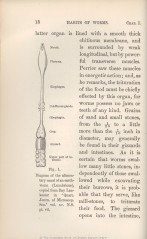
His final book, The formation of vegetable mould through the action of worms (1881), was published the year before his death. His notes for this project have recently been transcribed. In it Darwin made another important contribution, and, characteristically, revealed the amazing complexity and importance of a natural process of gradual accumulation, which no one seemed to have grasped before, and that had all along been under our feet.
One of the many myths about Darwin that still circulates today is that he repented of evolutionism or converted to Christianity on his deathbed. These stories are usually told by those who would like them to be true, but they are not. There are no mysteries surrounding Darwin's death; his relatives present at the time wrote detailed accounts of his last hours. The history of the legend, however, is revealed in James Moore, The Darwin legend (1994). For most of his life Darwin was not an atheist, but a deist; that is he believed that a creator had designed the universe and set up natural laws according to which all of nature was unwaveringly governed. It was the pursuit of a man of science to discover the laws by which nature operated. He discussed his religious views in his autobiography (these appear, however, only in the 1958 edition by Nora Barlow with original omissions restored.)
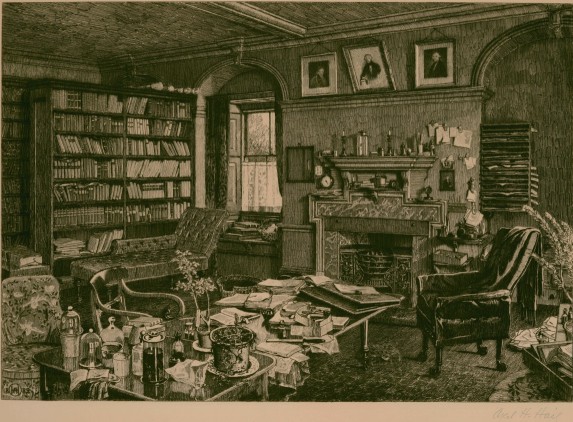
Darwin's new study at Down House, copper etching made shortly after his death by Axel Haig. This is a family copy.
Charles Darwin was a kind, good-humoured, pleasant man, unassuming and profoundly modest. He suffered from ill health much of his adult life. We will probably never know the causes for his illness(s). He nevertheless remained driven to understand nature and to remain part of the elite scientific world he respected and admired. Darwin died in April 1882 and is buried in Westminster Abbey. Read about his funeral here. There was an outpouring of obituaries around the world. These have been collected and published in Darwin Online. These reveal better than any other source, what Darwin's contemporaries felt he had achieved and why they regarded him as the most revolutionary figure in science in history.
After his death Darwin's private papers were mostly preserved and most of these were later deposited in Cambridge University Library. See Darwin's papers online.
In 1909 over 400 scientists and dignitaries from 167 different countries gathered at Cambridge to celebrate the centenary of Darwin's birth and the fiftieth anniversary of the publication of On the Origin of Species. The event was an unprecedented success - never before had such a celebration been held, not for an institution or a nation - but for an individual scientist. In the year 2009 the world witnessed another unprecedented celebration. The largest list of events and publications in that year is here.
See also:
The Complete Photographs of Darwin
The Complete Library of Charles Darwin
Timeline and Itinerary of Darwin's life
Darwin's personal 'Journal' (1809-1881). Introduction Text
The richest single work work on Darwin and his influence is Darwin: A Companion (2021).
The older edition is online here: Freeman, Charles Darwin: A companion. 2d online edition. (2007) Text
For more detailed accounts of Darwin's life on this site see:
The autobiography of Charles Darwin 1809-1882. With the original omissions restored. (1958) Text
The life and letters of Charles Darwin, including an autobiographical chapter. (1887)
vol. 1 Text; vol. 2 Text; vol. 3 TextMore letters of Charles Darwin. (1903) vol. 1 Text; vol. 2 Text
John van Wyhe, Charles Darwin: Justice of the peace. The complete records (1857-1882). (PDF)
To learn more about Darwin:
M. T. Ghiselin, Darwin: A reader's guide. Occasional Papers of the California Academy of Sciences, 2009.
Janet Browne, Charles Darwin: Voyaging.
Janet Browne, Charles Darwin: The power of place.
Janet Browne, Darwin's Origin of Species: A biography.
John van Wyhe, Dispelling the Darkness: Voyage in the Malay Archipelago and the discovery of evolution by Wallace and Darwin.
John van Wyhe, Charles Darwin: The compact guide. Welbeck, 2020. (Amazon.com, Amazon.co.uk)
John van Wyhe, Darwin, 2018. (Amazon.co.uk, Amazon.com, French, Spanish, Czech, Chinese, Thai, Vietnamese and Italian)
John van Wyhe, Charles Darwin: the man, his great voyage, and his theory of evolution. Pioneers of Science. New York: Rosen, 2022. (Amazon.com, Amazon.co.uk)
RN15








